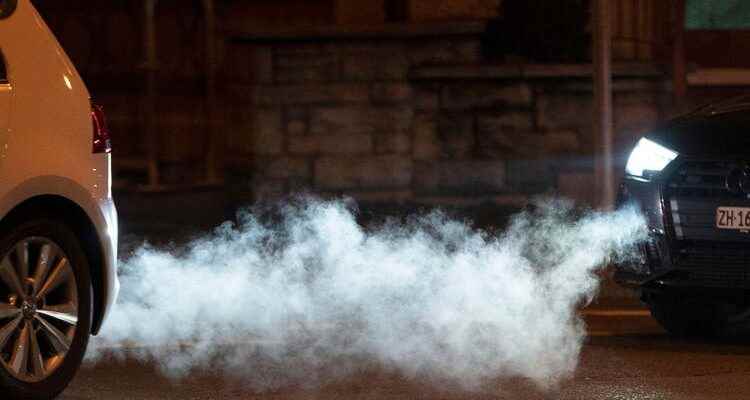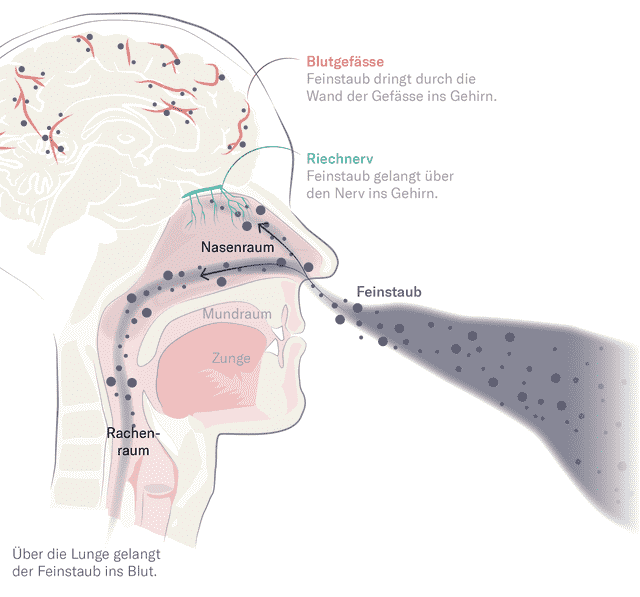In the child’s brain, exposure to particulate matter and nitrogen dioxide (NO2) did not pass without a trace, as scientific findings from the Netherlands show. However, it is currently almost impossible to escape from the particulate matter.
Particulate matter and nitrogen oxides from motorized traffic get into the brain. Road traffic in Zurich, February 2019.
A busy street, in the middle of it sits a helmeted toddler in a cargo bike. A car exhaust pipe just a few meters in front of his face. A reality of city life. “It’s definitely not healthy. But certainly not quite as harmful,” the parents try to calm down.
In fact, it is difficult to quantify the health effects of environmental exposure. Because it is often the chronic stress that leads to health consequences and thus only becomes measurable years later.
New findings could prompt some parents to choose the side street with little traffic and thus avoid one or the other smoking classic car or moped without a filter. Because small children could be particularly harmed by the pollutants in the air: their brain is in a delicate development phase in which important nerve connections are created. The inhaled pollutants – especially fine dust – could have a negative impact on this development.
The brain structure of 3000 children in Rotterdam was measured
In order to investigate the possible long-term health consequences of air pollutants, scientists use so-called cohort studies: Thousands of people are examined again and again over decades. In this way, a connection can be found between the occurrence of certain diseases and environmental factors.
One of these cohorts lives in Rotterdam. Between 2002 and 2009, almost 10,000 children were placed in the so-called Generation R study recorded. Most of the children were part of the study as fetuses, from the fourth month of pregnancy. In this way it can also be said retrospectively whether environmental factors during pregnancy could have had an impact on the development of the children.
In order to record the growth of the brain, the scientists used an imaging method known as diffusion tensor imaging (DTI). This allows the strength and course of the large nerve fiber bundles in the brain to be measured. Around 3000 children from the cohort volunteered for the measurement at the age of 10.
Air pollutants could affect brain development
The first results have now become known: The study finds a statistical connection between exposure to nitrogen dioxide (NO2) at the age of 2 to 5 years and brain development. The amount of fine dust inhaled, on the other hand, has an influence on the development of the brain structure even before birth and up to the age of 5 years. The lower the level of pollution, the more pronounced the nerve tracts in the brain were.
The level of inhaled air pollutants may therefore affect cell growth in the brain. However, it cannot be concluded from the available data whether these differences have any effect on the functioning of the brains of children and adolescents.
The differences in environmental exposure between 5 and 10 years, on the other hand, no longer seemed to affect brain structure. It is possible that the air pollutants play a role especially in the earlier, more delicate phase of brain development. However, it would also be possible that the defense mechanisms of the brain are better developed in later childhood.
Particulate matter already burdens the fetus
It was astonishing that the extent of particulate matter pollution during pregnancy could already have a statistical influence on the microstructure of the brain. Until now, many experts have assumed that the fetus is protected to a certain extent by the mother’s organism. But one Study published in Nature Communications in 2019 showed for the first time that particulate matter can enter the child’s organism during pregnancy.
The researchers used imaging to examine the placenta of pregnant women. All of the pregnant women examined showed fine dust in the tissue of the placenta. The more the mothers were exposed to air pollutants, the more fine dust the researchers found in the tissue. Since the most important large nerve tracts in the brain are created between the 13th and 18th week of pregnancy, it is possible that fine dust can influence the growth of the neuron connections during this time.
Particulate matter reaches the brain in two ways
Such cohort studies cannot provide an answer to the question of whether exposure to harmful substances and changes in brain development are causally related. In order to investigate the “mechanism of action”, animal experiments have to be carried out.
Experiments on laboratory animals show that there are two ways fine dust can get into the brain. On the one hand, the pollutants are distributed throughout the body via the blood. They can get into the surrounding tissue via the walls of the blood vessels. If this happens in the brain, it is said that the Spollutants break through the «blood-brain barrier».
Experiments with mice have not only shown that particulate matter reaches the brain via the bloodstream, but also that it stays there much longer than in other organs. But in contrast to other organs, the brain has another gateway for air pollutants such as particulate matter. Because fine dust and nitrogen oxides can also come from the nose enter the brain directly via the olfactory nerve.
Fine dust transports toxic substances into the brain
Once the particles are in the brain, they are broken down only poorly. There they lead to so-called oxidative stress, which can damage the tissue. In addition, other toxins attach themselves to the fine dust particles, which get into the brain together with the fine dust particles and have to be fought by the brain’s antioxidant system.
The findings are particularly worrying because the estimated air pollution in Generation R is already well below the applicable limit values, says Mònica Guxens, who was involved in the study. The epidemiologist works at the Barcelona Institute of Global Health.
The World Health Organization (WHO) regularly proposes limit values for pollutants in the environment on the basis of new research results. Based on new findings, it has the limit values for NO2 and particulate matter reduced in 2021.
WHO: There is no such thing as a harmless level of particulate matter pollution
This assessment by the WHO is not based on studies of brain development, but on more general epidemiological studies. These show that particulate matter and NO2 significantly increase the likelihood of getting sick or dying. Based on these studies, the WHO writes that there is no threshold value that can guarantee health safety.
Up to 70 cohort studies were taken into account when the WHO assessed the particulate matter limit values, says Barbara Hoffmann, who heads the Institute for Environmental Epidemiology at the University of Düsseldorf. The assessment not only includes results from cohort studies and other epidemiological studies, but also the assessment of whether a connection is causal or likely to be causal.
You can hardly escape the fine dust
According to the WHO, no more than an average of 5 micrograms of PM2.5 particulate matter should be inhaled per cubic meter of inhaled air. PM2.5 are particles with a diameter of 2.5 microns and smaller. In Switzerland, the limit values are set out in the Federal Air Pollution Control Ordinance (LRV). That for particles of size P2.5 and smaller is 10 micrograms per cubic meter.
To escape air pollutants, it pays to avoid their sources. The source of particulate matter and NO2 in the air in Switzerland comes to a large extent from motorized road traffic. In the city of Zurich, for example, it is the cause of 50 percent of the nitrogen oxide pollution and a large part of the particulate matter pollution. But industrial plants are also among the sources of particulate matter.
Certain air pollutants, above all the NO2, decrease significantly away from roads. Nevertheless, you can hardly escape the fine dust. Because the so-called background load is relatively high. For example, on the Üetliberg, the average annual pollution level for fine dust of the size PM2.5 almost reaches the limit value of the Air Pollution Control Ordinance, says research associate Markus Scheller from Environmental and Health Protection in Zurich.
Parents can therefore do little to prevent their children from being exposed to air pollution. But knowing that fine dust accumulates over time to form larger particles and is therefore less likely to get into the bloodstream and brain, the detour down the side street might be worth it. The pollution with nitrogen oxides is definitely lower there.

